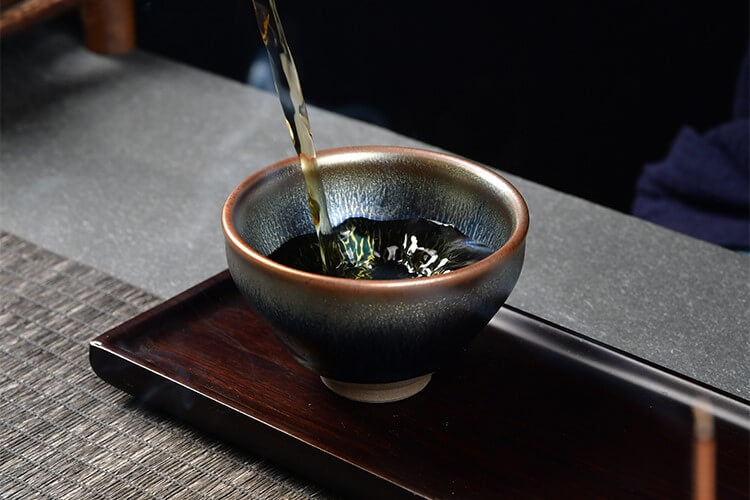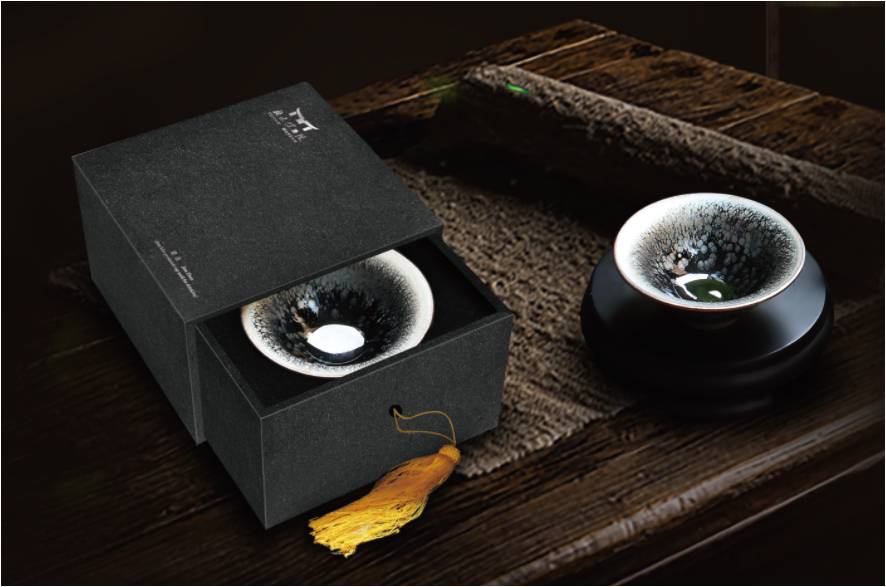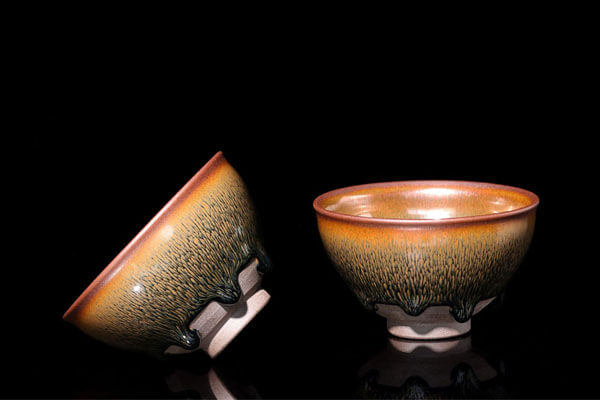Tenmoku Jian Zhan and Historical Status in Tea Culture
Throughout long history of tea culture, tea utensils have played a pivotal role as vessels of tradition and artistry. Ancient tea connoisseurs were discerning not only about the tea itself but also about the tools used to brew and serve it. Diverse materials, shapes, and decorative techniques—such as poetry, calligraphy, painting, and carvings—elevated tea ware to new aesthetic heights.
As tea varieties multiplied, so did demands for tea utensils in terms of color, texture, size, and function. This spurred innovation in craftsmanship, giving rise to a rich ecosystem of tea ware that mirrored evolving cultural preferences.
What Are the Characteristics of Jian Zhan?
-
Glaze:
- Color: Black glaze.
- Type: Crystalline glaze, formed by iron oxide crystallization at high temperatures.
- Firing: High-temperature glaze (exceeding 1300°C).
-
Clay and Iron Content:
- The clay body, known as “iron胎” (tie tai), is iron-rich, giving it a dark gray hue.
- The glaze contains high iron oxide, which forms natural crystalline patterns on the black base.
-
Signature Patterns:
- Hare’s Fur (tuhao): Fine, streaked lines resembling rabbit fur.
- Oil Spot (youdi): Metallic speckles.
- Yohen (曜变): Rare iridescent “starry” patterns.
- Mottled Glaze: Varied textures like partridge feathers or persimmon-red hues.
- Each piece is unique, with unpredictable crystallization.
-
Forms Designed for Tea:
- Four primary shapes: shukou (contracted rim), piekou (flared rim), liankou (narrowed mouth), and changkou (wide mouth).
- The shukou type, with its inward-curving lip, is iconic for enhancing tea froth during Song-era whisking.
-
Glazing Technique:
- Thick glaze applied partially, leaving unglazed “dry rims” (gankou) and exposed clay at the base.
-
Uniqueness and Rarity:
- Low success rate due to complex firing conditions. No two Jian Zhan are identical.
Jian Zhan’s Historical Significance
During the Song Dynasty (960–1279), when doucha (tea competitions) and whisked tea dominated, Jian Zhan reigned as the ultimate tea vessel. Emperors like Huizong, scholars like Cai Xiang, and commoners alike cherished it. Archaeological discoveries of dragon kilns in Jianyang—some stretching over 135 meters—attest to its mass production and widespread popularity. It was, in essence, the “national tea bowl” of the Song era.
After the Song, shifting tea trends caused Jian Zhan to fade in China. Yet in Japan, it remained revered: four Jian Zhan are designated as National Treasures. Museums worldwide, including the British Museum and the Metropolitan Museum of Art, house Song-era examples.
Reevaluating Jian Zhan’s Legacy
Post-Song, Jian Zhan was overshadowed by celadon and white porcelain. Some scholars argue it deserves greater recognition as the pinnacle of black-glazed ceramics. While Song celadon and white wares served diverse purposes (vases, dishes, pillows), Jian Zhan was singularly dedicated to tea. Its dominance in the tea bowl category was unmatched.
The sheer scale of Jianyang’s kilns—evidenced by record-breaking 135.6-meter dragon kilns—proves its monumental demand. Like Yue celadon in the Tang, Jian Zhan was the Song’s definitive tea icon.
A Modern Renaissance
Today, Jian Zhan is reclaiming its glory. On September 15, a Song-era “oil spot” bowl sold for ¥78 million at a U.S. auction, underscoring its soaring collectible value. Contemporary artisans, reviving ancient techniques, attract modern tea enthusiasts who prize its fusion of utility and artistry.
In the 21st century, tea aesthetics embrace diversity: white porcelain, celadon, and black glaze coexist. No single style dominates, yet Jian Zhan’s revival—as a cultural relic and functional art—marks a triumph. Once obscured, this “pearl of black-glazed porcelain” now shines anew, a testament to Song craftsmanship and a gift to the world.






